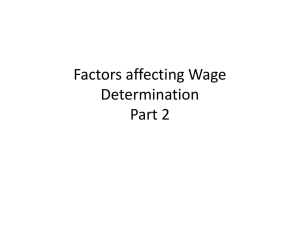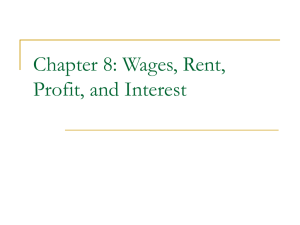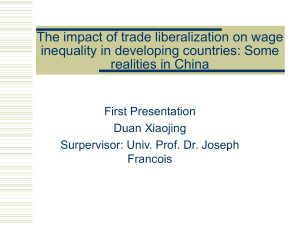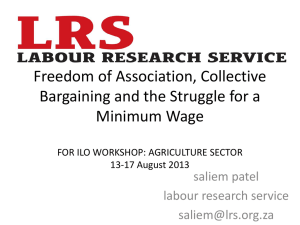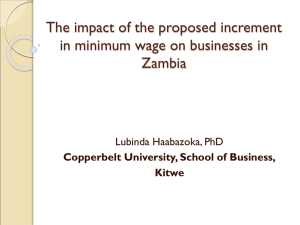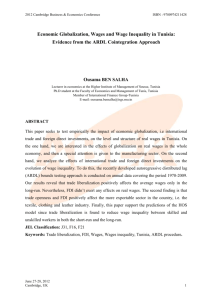CHAPTER 2:TRADE AND WAGES
advertisement
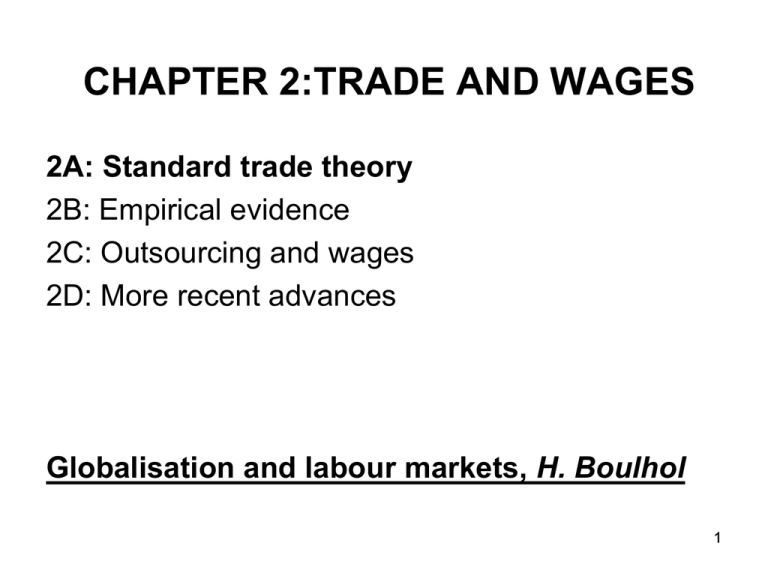
CHAPTER 2:TRADE AND WAGES 2A: Standard trade theory 2B: Empirical evidence 2C: Outsourcing and wages 2D: More recent advances Globalisation and labour markets, H. Boulhol 1 2A: Stylised facts • Increase in inequality between low-skilled and highskilled workers in developed countries since the 1970s: - wage inequality in Anglo-saxon countries - employment inequality in some European countries • Labour market institutions might explain the different outcomes across countries (Chapter 3) • Downward trends in the labour share (in value added) • These facts are qualitatively consistent with standard trade theory. Quantitatively ? (2B) 2 2A: Standard trade theory • Comparative advantages arise from - technological differences (Ricardian model) factor endowment differences (HOS) • Both matter in the real world (but insufficient to explain patterns of trade) • Long-term outcomes of trade • Short-term impact and adjustment towards long-term equilibrium (chapter 5) 3 2A: Heckscher-Ohlin-Samuelson model • 2 x 2 x 2 model, capital & labour, common technology Yi f i ( K i , L i ) , i 1, 2 c.r.s. , K1 K 2 K L1 L2 L factors are mobile across sectors, immobile across countries Assumption: sector 1 is labour intensive (w, r ) , L1 / K1 L2 / K 2 free entry under perfect competition: pi ci (w, r ) c i ( w, r ) : minimum cost of producing one unit of output (unit-cost ) = marginal cost = average cost per unit of output 4 2A: Factors shares in output / total costs Notations: a iL optimal choice of L to produce one unit of good i a iK optimal choice of K to produce one unit of good i c.r.s. aiL Li / Yi , aiK K i / Yi ci (w, r ) w aiL (w, r ) r aiK (w, r ) iL wLi w a iL p i Yi ci , iK rK i r a iK 1 iL p i Yi ci L1 / K1 L2 / K 2 a1L / a1K a 2 L / a 2 K 1L 2 L 1K 2 K 5 2A: Jones (1965)’ algebra pi w aiL r aiK dpi aiL dw aiK dr pˆ i iL wˆ iK rˆ wˆ (envelope theorem) i 1, 2 2 K pˆ 1 1K pˆ 2 1K pˆ 1 ( pˆ 1 pˆ 2 ) 2 K 1K 2 K 1K pˆ pˆ 2L rˆ 1L 2 2 L 1 pˆ 2 ( pˆ 1 pˆ 2 ) 1L 2 L 1L 2 L 6 2A: Trade and convergence of relative factor prices Source: Krugman and Obstfeld, chapter 4 7 2A: Trade and convergence of relative factor prices Total integration ensure factor price equalisation (FPE) … … provided that both goods are still produced in each country 8 2A: Magnification effect of trade If domestic country is labour intensive Trade implies that pˆ 1 pˆ 2 and therefore wˆ pˆ 1 pˆ 2 rˆ 9 2A: Stolper-Samuelson theorem • One of the central results of Heckscher-Ohlin theory • What is the effect of changes in the prices of goods, caused for example by changes in tariffs or subsidies, on the prices of factor of production? • Unambiguous answer: An increase in the relative price of a good will increase the real return to the factor used intensively in that good, and reduce the real return to the other factor 10 2A: Intuition (Neary) • • • - - One sector produces exports, the other sector competes with imports Suppose the import-competing sector is labour-intensive: it uses a higher ratio of labour to capital What is the effect of a tariff or some other change which raises the price of the import-competing good? this will encourage the import-competing sector to expand with full employment of both factors, this expansion must come at the expense of the export sector expansion of the labour-intensive sector and contraction of the capitalintensive one raise the aggregate demand of labour relative to capital: upward pressure on wage at unchanged export prices, a higher wage implies a lower capital return the wage must then rise even more than the import price wage-earners gain and capital-owners lose: trade policy generates a distributional conflict 11 2A: Stolper-Samuelson theorem • A country that is relatively abundant in labour specialises in the labour-intensive good. In that country, the real wage increases and the real return to capital decreases. It is the opposite for the country that is relatively abundant in capital • Low-skilled labour and high-skilled labour • Distributional consequences: gainers and losers from increased trade opportunities 12 2A: Graphical representation of SS theorem Source: Feenstra, chapter 1 13 2A: Gainers, losers, and total gains from trade • Debate arises when distributional effects of trade imply an increase in inequalities • We tend to hear more about losers than gainers: - Losers from trade are typically concentrated in some sectors, while a vas majority benefits, at least in theory, from lower import prices Losers are therefore better organised • Aggregate gains from trade: both gains and pains are commensurate with each other to a certain extent The larger the differences in endowments between countries, the larger the total gains, and the dearer the pains for the losers 14 2A: Gainers, losers, and total gains from trade (continued) • In theory, overall gains from trade means that losers can be compensated, such that ex post everybody gains • In practice: - difficult to identify the losers (from trade) - Difficult to find the political support to compensate them - The impact of globalisation on tax competition reduces the scope of governments’ tax policies (see chapter 5) 15 2A: Limitations • Many goods, many factors (Feenstra, chap. 3) A version of SS continues to hold, though not quite as strong as the 2 sector by 2 factor case • Imperfect mobility of a factor between sectors (specific factor model, see chapter 5) effect on the real return of the mobile factor is ambiguous • Total specialisation: non-competing imports what matters is the relation between factor prices and the prices of goods produced domestically (binding zero profit conditions): the price of noncompeting goods matter only for CPI, not for the wages paid by producers. FPE works if differences in (relative) factor endowments are not too large 16 2A: Limitations (continued) • More than 2 countries “local” rather than global factor abundance matters, i.e. compare a country’s factor abundance to others’ that produce the same set of goods (Milanovic and Squire,2005; 2D) • Trade in intermediate inputs (outsourcing) Chapter 2C Paper 3: Grossman and Rossi-Hansberg (2008) 17 References 2A Feenstra, R.C., 2003. Advanced International Trade: Theory and Evidence. Princeton University Press. Chapters 1 & 3 Krugman, P.R., Obstfeld, M., 2008. International Economics, Chapter 6, Eighth edition, Pearson eds. Neary, P., 2001. Competition, trade and wages, http://www.economics.ox.ac.uk/members/peter.neary/papers/pdf/intea.pdf 2B Autor, D.H., Katz, L.F., Kearney, M.S., 2006. The Polarization of the U.S. Labor Market, American Economic Review 96 (2). Autor, D.H., Katz, L.F., Kearney, M.S., 2008. Trends in U.S. Wage Inequality: Reassessing the Revisionists, review of Economics and Statistics, May. Borjas, G.J., Ramey, V.A., 1995. Foreign Competition, Market Power and Wage Inequality. Quarterly Journal of Economics, November, 1075-1110. Blum, B.S., 2008. Trade, technology, and the rise of the service sector: The effects on US wage inequality, Journal of International Economics 74 (2), 441-458. Dinopoulos, E., Segerstrom, P., 1999. A Schumpeterian Model of Protection and Relative Wages, American Economic Review 89 (3). Dustmann, C., Ludsteck, J., Schönberg, U., 2007. Revisiting the German Wage Structure, IZA Discussion Paper 2685. Feenstra, R.C., Hanson, G.H., 2003. Global Production Sharing and Rising Wage Inequality : A 18 Survey of Trade and Wages, Handbook of International Trade. Goldberg, P.K., Pavcnik, N., 2007. Distributional Effects of Globalization in Developing Countries, Journal of Economic Literature, Vol. XLV, 39-82. Harrison, A., 2008. Globalization and Poverty Journal of International Economics, 2001. Special issues: Trade and Wages, 54 (1). Journal of International Economics, 2000, 50 (1). Lemieux, T., 2007. The Changing Nature of Wage Inequality, NBER Working paper 13523. Thoenig, M., Verdier, T., 2003. A Theory of Defensive Skill-Biased Innovation and Globalization, American Economic Review, 93 (3), 709-728. 2C Feenstra, R.C., 2003. Advanced International Trade: Theory and Evidence. Princeton University Press. Chapter 4. Feenstra, R.C., Hanson, 1996. Globalization, Outsourcing, and Wage Inequality, American Economic Review, vol. 86, issue 2, pages 240-45. Grossman, G.M., Rossi-Hansberg, E., 2008. Trading Tasks: A Simple Theory of Offshoring, American Economic Review, 98 (5), 1978-1997. 2D Amiti, M., Davis, D.R., 2008. Trade, Firms, and Wages: Theory and Evidence, CEPR Discussion Paper No 6872. Egger, H., Kreickemeier, U., 2008. CESIfo WP 2344. Milanovic, B., Squire, L., 2005. NBER 11046 Yeaple, S., 2005. A simple model of firm heterogeneity, international trade, and wages, Journal 19 of International Economics 65, 1-20.
